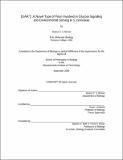[GAR⁺] : a novel type of prion involved in glucose signaling and environmental sensing in S. cerevisiae
Author(s)
Brown, Jessica C. S
DownloadFull printable version (3.119Mb)
Alternative title
Novel type of prion involved in glucose signaling and environmental sensing in S. cerevisiae
Other Contributors
Massachusetts Institute of Technology. Dept. of Biology.
Advisor
Susan Lindquist.
Terms of use
Metadata
Show full item recordAbstract
Several well-characterized fungal proteins act as prions, proteins capable of multiple conformations, each with different activities, at least one of which is selfpropagating. We report a protein-based heritable element that confers resistance to glucosamine, [GAR⁺]. Genetically it resembles other yeast prions: it appears spontaneously at a rate higher than mutations and is transmissible by non-Mendelian, cytoplasmic inheritance. However, [GAR⁺] is in other ways profoundly different from known prions. [GAR⁺] propagation involves Pmal, the plasma membrane protein pump, and [GAR⁺] formation is induced by Stdl, a member of the Snf3/Rgt2 glucose signaling pathway. Also, [GAR⁺] does not appear to involve the formation of an amyloid template and the prion state represents only a fraction of the Pmal protein in the cell,· consistent with the prion form constituting a complex between Pmal and Stdl, a much lower abundance protein. [GAR⁺] propagation is subject to a strong species barrier, as substitution of PMAl from other Saccharomyces species blocks propagation to s.. cerevisiae PMAl. Direct competition between [gar-] and [GAR⁺] cells indicate that cells carrying [GAR⁺] have an advantage under certain environmental conditions. [GAR⁺] appears spontaneously in a yeast isolated from a variety of sources and can be induced by co-culturing yeast and a number of Staphylococcus species. Overall, [GAR⁺] expands the conceptual framework for self-propagating protein-based elements of inheritance to include non-amyloid, potentially multicomponent systems such as transmembrane proteins and signal transducers.
Description
This electronic version was submitted by the student author. The certified thesis is available in the Institute Archives and Special Collections. Thesis (Ph. D.)--Massachusetts Institute of Technology, Dept. of Biology, 2008. Includes bibliographical references.
Date issued
2008Department
Massachusetts Institute of Technology. Department of BiologyPublisher
Massachusetts Institute of Technology
Keywords
Biology.